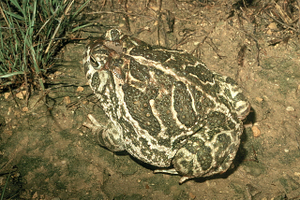Female Great Plains toads are more likely to mate with males that call frequently. However, some males may sit quietly near calling males and sometimes intercept and successfully mate with females approaching the calling male.
Photo Credit: Geoffrey A. Hammerson
Anaxyrus cognatus
Common Name: Great Plains toad
Other Scientific Names: Bufo cognatus
Animal Guild: Amphibian
Class > Order > Family: Amphibia > Anura > Bufonidae
What does the species look like?
The upper surface has a somewhat symmetrical pattern of large, light-edged dark spots. The skin has numerous small warts. Cranial crests (hard ridges) are prominent between eyes and diverge posteriorly from a hard lump on top of the snout. The parotoid glands (glandular swellings behind the eyes) are much longer than wide. The underside of each hind foot often has a sharp-edged tubercle and a smaller dark-tipped tubercle. Females grow up to 4.5 inches (11.4 cm) snout-vent length, while males usually are less than 3.7 inches ( 9.5 cm). During the breeding season, breeding males have dark, loose throat skin and a dark patch on the inner surface of the thumb. The male's expanded vocal sac is large, elongated, and may extend upward in front of the face. The breeding call is a long, continuous trill or pulsating ringing sound lasting at least several seconds; at close range it is similar to the ear-splitting sound of a jack-hammer. The sound varies somewhat with temperature and size of male; loud nasal quacks sometimes precede the trill. Juveniles have reddish warts, and recently metamorphosed toadlets may be as small as 1 cm. Larvae are initially blackish, then become more pale and mottled brown and gray dorsally; under magnification, the dark skin may have an overlying golden suffusion. The pattern of large paired blotches on the back appears before metamorphosis is complete. The eyes of larvae are high on the head, and the dorsal fin (located on back) is highly arched. The fins are clear with some black branching lines, mainly in the upper fin. Sometimes there is extensive mottling in the upper and lower fins. The tail musculature lacks an unpigmented band along the lower margin. Larvae may grow up to at least 1.4 inches (3.5 cm) in total length. Eggs are black above, whitish below, about 1.1-1.2 mm in diameter. Usually eggs are in a single row in long strings of two-layered jelly that is constricted between the eggs; partitions separate the eggs from each other.
Where is the species found?
States & Provinces
AB, AZ, CO, IA, KS, MB, MN, MO, MT, ND, NE, NM, NV, OK, SD, SK, TX, UT, WY
Distribution
Range encompasses the Great Plains, southwestern United States, and northern Mexico, from southern Manitoba and southeastern Alberta in Canada, south to Aguascalientes and San Luis Potosi, Mexico; east to western Minnesota, western Iowa, central Missouri, central Oklahoma, and northern and western Texas; west to central Montana, eastern Wyoming, eastern and south-central Colorado, southeastern California. In the western segment of the distribution, the range extends north through southern Nevada and Arizona to northern Utah and south to Sonora and northern Sinaloa. Distribution in the desert part of the range is highly fragmented. Elevational range is mostly between sea level and 6,000 feet (1,800 meters) but extends to 8,000 feet (2,440 meters) in Colorado.
Great Plains toads inhabit deserts, grasslands, semidesert shrublands, open floodplains, and agricultural areas, typically in stream valleys. Calling males sit along the shoreline or brace themselves on submerged plants. Breeding sites include rain pools, flooded areas, and ponds and reservoirs that fluctuate in size.
General Phenology and Life History
These toads are inactive during cold winter months and during summer dry spells. Most activity is nocturnal, but these toads may active in daytime during wet or humid weather or when breeding. When not active on the surface they occupy underground burrows. Breeding occurs after warm rains in spring or summer. Male breeding choruses in a particular site usually last at least a few days but are of variable duration (up to two weeks or more). Individual females deposit clutches of several thousand eggs in shallow water. Eggs hatch in a few days, and larvae metamorphose in 2.5-7 weeks (depending on temperature and larval density).
Which phenophases should I observe?
Do you see/hear...?
Activity
Adults on land More...
For abundance, enter the number of individual animals observed in this phenophase.
Adults in water More...
For abundance, enter the number of individual animals observed in this phenophase.
Adults feeding For abundance, enter the number of individual animals observed in this phenophase.
Reproduction
Vocalizing What is the intensity of vocalizing?
Single calls: There is space between calls and individuals can be counted. Overlapping calls: Calls of individuals can be distinguished but there is some overlapping of calls. Full chorus: Calls are constant and overlapping.
Mating For abundance, enter the number of individual animals observed in this phenophase.
Fresh eggs For abundance, enter the number of individual animals observed in this phenophase.
Development
Dead adults For abundance, enter the number of individual animals observed in this phenophase.
What do these phenophases look like?
There is currently no photoguide available for this species. If you'd like help us create one, use the guidance document and species template provided here . Then send it via email to education@usanpn.org when it is complete.
